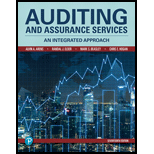
Auditing And Assurance Services
17th Edition
ISBN: 9780134897431
Author: ARENS, Alvin A.
Publisher: PEARSON
expand_more
expand_more
format_list_bulleted
Concept explainers
Question
Chapter 16, Problem 20.2MCQ
To determine
Indicate the causes of the decrease in account receivable turnover.
Expert Solution & Answer
Want to see the full answer?
Check out a sample textbook solution
Students have asked these similar questions
Please give me correct answer
per period?
Financial accounting
Chapter 16 Solutions
Auditing And Assurance Services
Ch. 16 - Prob. 1RQCh. 16 - Prob. 2RQCh. 16 - Prob. 3RQCh. 16 - Prob. 4RQCh. 16 - Explain why you agree or disagree with the...Ch. 16 - Prob. 6RQCh. 16 - Prob. 7RQCh. 16 - Prob. 8RQCh. 16 - Prob. 9RQCh. 16 - Prob. 10RQ
Ch. 16 - Prob. 11RQCh. 16 - Under what circumstances is it acceptable to...Ch. 16 - Prob. 13RQCh. 16 - Prob. 14RQCh. 16 - Prob. 15RQCh. 16 - Prob. 16RQCh. 16 - Prob. 17RQCh. 16 - Prob. 18RQCh. 16 - Prob. 19RQCh. 16 - Prob. 20.1MCQCh. 16 - Prob. 20.2MCQCh. 16 - Prob. 20.3MCQCh. 16 - The following questions deal with confirmation of...Ch. 16 - Prob. 21.2MCQCh. 16 - Prob. 21.3MCQCh. 16 - Prob. 22.1MCQCh. 16 - Prob. 22.2MCQCh. 16 - Prob. 22.3MCQCh. 16 - Prob. 23.1MCQCh. 16 - Which of the following is least likely to be a...Ch. 16 - The following questions concern auditor...Ch. 16 - Prob. 24DQPCh. 16 - Prob. 25DQPCh. 16 - Prob. 26DQPCh. 16 - The following misstatements are sometimes found in...Ch. 16 - Prob. 28DQPCh. 16 - Prob. 29DQPCh. 16 - Prob. 30DQPCh. 16 - Prob. 31DQPCh. 16 - Prob. 32DQPCh. 16 - Prob. 33DQPCh. 16 - Prob. 34DQPCh. 16 - Prob. 35DQPCh. 16 - Prob. 36DQPCh. 16 - Prob. 38DQPCh. 16 - Prob. 39ICA
Knowledge Booster
Learn more about
Need a deep-dive on the concept behind this application? Look no further. Learn more about this topic, accounting and related others by exploring similar questions and additional content below.Similar questions
arrow_back_ios
SEE MORE QUESTIONS
arrow_forward_ios
Recommended textbooks for you
 Auditing: A Risk Based-Approach to Conducting a Q...AccountingISBN:9781305080577Author:Karla M Johnstone, Audrey A. Gramling, Larry E. RittenbergPublisher:South-Western College Pub
Auditing: A Risk Based-Approach to Conducting a Q...AccountingISBN:9781305080577Author:Karla M Johnstone, Audrey A. Gramling, Larry E. RittenbergPublisher:South-Western College Pub Auditing: A Risk Based-Approach (MindTap Course L...AccountingISBN:9781337619455Author:Karla M Johnstone, Audrey A. Gramling, Larry E. RittenbergPublisher:Cengage LearningPrinciples of Accounting Volume 1AccountingISBN:9781947172685Author:OpenStaxPublisher:OpenStax College
Auditing: A Risk Based-Approach (MindTap Course L...AccountingISBN:9781337619455Author:Karla M Johnstone, Audrey A. Gramling, Larry E. RittenbergPublisher:Cengage LearningPrinciples of Accounting Volume 1AccountingISBN:9781947172685Author:OpenStaxPublisher:OpenStax College EBK CONTEMPORARY FINANCIAL MANAGEMENTFinanceISBN:9781337514835Author:MOYERPublisher:CENGAGE LEARNING - CONSIGNMENT
EBK CONTEMPORARY FINANCIAL MANAGEMENTFinanceISBN:9781337514835Author:MOYERPublisher:CENGAGE LEARNING - CONSIGNMENT

Auditing: A Risk Based-Approach to Conducting a Q...
Accounting
ISBN:9781305080577
Author:Karla M Johnstone, Audrey A. Gramling, Larry E. Rittenberg
Publisher:South-Western College Pub

Auditing: A Risk Based-Approach (MindTap Course L...
Accounting
ISBN:9781337619455
Author:Karla M Johnstone, Audrey A. Gramling, Larry E. Rittenberg
Publisher:Cengage Learning

Principles of Accounting Volume 1
Accounting
ISBN:9781947172685
Author:OpenStax
Publisher:OpenStax College

EBK CONTEMPORARY FINANCIAL MANAGEMENT
Finance
ISBN:9781337514835
Author:MOYER
Publisher:CENGAGE LEARNING - CONSIGNMENT